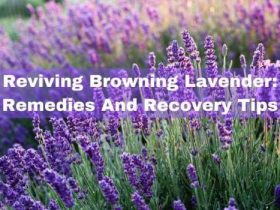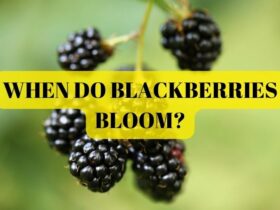When choosing the perfect flowering plant for your garden or home, lavender and Lilac are two of the most popular options. Both boast stunning blooms and a pleasant fragrance, but they differ in many ways, from their physical characteristics to their cultural significance.
Whether you’re a gardener, a decorator, or a lover of all things floral, understanding the differences between Lavender vs Lilac can help you choose the perfect plant for your needs.
So let’s dive in and explore the adorable lavender vs lilac world!
Physical Characteristics
When debating the physical characteristics of lavender vs Lilac, you must have lots of knowledge. Thus, read this section to win the debate!
A. Lavender
Colour:
Lavender is known for its beautiful purple colour, which varies in shades from light lavender to deep violet.
The flowers grow in dense spikes and are tubular, each measuring about 2-3 millimetres in diameter. Some varieties of lavender also produce pink, white, or blue flowers, but purple is the most common colour.
Height:
Lavender typically grows to 2-3 feet but can grow taller in ideal conditions. The plant has long, slender stems covered with silvery-green leaves with numerous tiny flowers. The stem is woody at the base, but the upper part is soft and flexible.
Leaves:
Lavender leaves are narrow and lance-shaped, measuring about 2-6 centimetres long. They are arranged alternately along the stem and have a silvery-green colour due to the fine hairs on their surface.
The leaves are highly fragrant and release a strong aroma when rubbed between the fingers. Lavender leaves are commonly used in cooking, tea, and aromatherapy.
B. Lilac
Colour:
Lilac produces large, showy flowers in late spring or early summer, which grow in cone-shaped clusters called panicles. The flowers are tubular and have four petals that form a funnel shape. Lilac flowers come in various colours, from pure white to deep purple, with shades of pink, lavender, and blue in between. The most common colour of lilac flowers is light purple.
Height:
Lilac is a deciduous shrub that typically grows to a height of 6-10 feet, but it can grow taller in ideal conditions. The plant has a rounded shape with many branches and produces large, fragrant flower clusters. Small, brownish seed pods follow lilac blooms in the spring and the flowers.
Leaves:
Lilac leaves are simple and heart-shaped, with a bright green colour. They measure 2-4 inches long and are arranged in pairs along the stem. The leaves have a smooth, glossy texture and a slightly serrated edge. Lilac leaves are not as fragrant as lavender leaves but are still an attractive plant feature. In the fall, the leaves turn yellow before dropping off for the winter.
FACT ALERT! Lavender and Lilac are both members of the mint family, and their leaves contain aromatic oils that release a pleasant fragrance when crushed or bruised.
Differences In Colour Between Lavender Vs Lilac:

One of the most commonly debated subjects is Lavender vs Lilac colour. They may look alike, but there are quite a few differences that you must know.
| Characteristic | Lavender | Lilac |
| Colour | Shades of purple, blue, pink, and white | Shades of purple, pink, and white |
| Dominant Colours | Purple and Blue | Purple and Pink |
| Shades | Includes pastels, dark, and light shades | Mostly pastel shades with a few dark and light variations |
| Other Colours | May also have some white and pink hues | May also have some white hues |
Cultivation and Maintenance
A. Lavender
Soil Requirements:
Lavender thrives in well-draining soil with a pH range of 6.5-7.5. It prefers sandy or gravelly soil that is not too rich in nutrients. The soil should be eased and amended with organic matter, like compost or aged manure, before planting to improve drainage and soil structure.
Watering Needs:
Lavender is drought-tolerant and does not require frequent watering once established. It prefers to be watered deeply but infrequently, allowing the soil to dry. Overwatering can cause problems like root rot, so avoiding watering too much is essential.
Sunlight:
Lavender requires total sun exposure to thrive, meaning it needs at least 6-8 hours of direct sunlight daily. It can tolerate some shade, but too much can cause the plant to become leggy and produce fewer flowers.
B. Lilac
Soil Requirements:
Lilac grows best in well-draining soil with a pH range of 6.0-7.0. It prefers slightly alkaline soil that is rich in nutrients and organic matter. To improve soil fertility and drainage, the soil should be loosened and fixed with compost or aged manure before planting.
Watering Needs:
To establish a robust root system, Lilac requires regular watering, particularly during the first year after planting.
It prefers to be watered deeply but rarely, allowing the soil to dry out between waterings. It may need additional watering during drought to prevent stress and maintain healthy growth.
Sunlight:
Lilac requires total sun exposure to bloom profusely, meaning it needs at least 6-8 hours of direct sunlight daily. It can tolerate some shade, but too much shade can reduce the number of flowers produced.
Did you know that lavender and Lilac prefer well-drained soil and thrive in full sunlight, but overwatering can harm their growth?
Uses
A. Lavender
Aromatherapy:
Lavender is widely used in aromatherapy due to its calming and relaxing properties. It is believed to reduce stress and anxiety and promote better sleep.
Lavender essential oil is used in diffusers, candles, and other products to create a soothing atmosphere.
Culinary Uses:
Lavender is used in cooking and baking as a flavorful herb. It has a slightly sweet and floral flavour and can be used in savoury and sweet dishes. Lavender flowers often make tea, syrups, and even cocktails.
Ornamental Uses:
Lavender is famous for its beautiful purple flowers and is commonly used in gardens and landscapes as an ornamental plant. It is also used in dried flower arrangements and potpourri.
B. Lilac
Ornamental Uses:
Lilac is primarily grown for its fragrant and attractive flowers, which come in various colours, from pink to purple to white. It is often used as a shrub or small tree in gardens and landscapes.
Fragrance:
Lilac is known for its sweet and floral fragrance, which is widely used in perfumes, soaps, and other personal care products. The essential oil from lilac flowers is also used in aromatherapy to promote relaxation and reduce stress.
Medicinal Uses:
Lilac has a long history of use in traditional medicine for its anti-inflammatory and antimicrobial properties. It is believed to help with skin conditions such as eczema, acne, and digestive and respiratory problems.
Did you know? Lavender can also be used to repel insects, and lilac flowers can be used to make a fragrant syrup that can be used in cocktails or drizzled over desserts.
Symbolism and Cultural Significance

A. Lavender
Symbolism in different cultures:
Lavender has been used symbolically in many cultures throughout history. In ancient Egypt, it was used in the mummification process, while in ancient Greece, it was used to purify the air and as a natural remedy for various ailments.
In Christianity, lavender symbolises purity and cleanliness, and it is often associated with the Virgin Mary.
Lavender in literature and art:
Lavender has been referenced in literature and art for centuries. In William Shakespeare’s play “Hamlet,” Ophelia famously says, “There’s rosemary, that’s for remembrance, and there are pansies, that’s for thoughts…there’s lavender, that’s for faithful lovers.”
Lavender has also been featured in numerous paintings and sculptures, including Vincent van Gogh’s famous “Vase with Twelve Sunflowers.”
B. Lilac
Symbolism in different cultures:
Like lavender, Lilac has been used symbolically in various cultures throughout history. In ancient Greek mythology, the god Pan was said to be in love with a nymph named Syringa, who transformed into a lilac bush to escape his advances. Lilacs are also associated with Easter and rebirth in Christianity.
Lilac in literature and art:
Lilacs have been featured in literature and art for centuries as well. In the novel “Little Women” by Louisa May Alcott, Meg is described as carrying “a huge bouquet of purple and white lilacs, which filled the air with their sweet breath.”
The artist Mary Cassatt often included lilacs in her paintings, and the French painter Édouard Manet famously painted a bouquet of lilacs in his painting “Spring.”
FUN FACT! During the Victorian era in England, lavender symbolised devotion and loyalty between lovers. Women would often tuck a lavender sprig into their beloved’s handkerchief, and men would carry it with them as a token of their love.
Differences Between Lavender And Lilac:
| Characteristic | Lavender | Lilac |
| Colour | Shades of purple, blue, pink, and white | Shades of purple, pink, and white |
| Height | 1 to 3 feet | 5 to 15 feet |
| Leaves | Narrow, grey-green leaves | Heart-shaped, dark green leaves |
| Soil Requirements | Well-drained, alkaline soil | Rich, well-drained soil |
| Watering Needs | Infrequent, deep watering | Regular watering |
| Sunlight | Full sunlight | Full sunlight to partial shade |
| Aromatherapy | Lavender oil is used for relaxation and stress relief | Lilac fragrance is used in perfumes and cosmetics |
| Culinary Uses | Lavender flowers are used in teas, baked goods, and other dishes | Lilac flowers can be used to flavour syrups and desserts |
| Ornamental Uses | Widely used in gardens and landscaping | Commonly grown as a decorative shrub or small tree |
| Fragrance | Strong, sweet, floral aroma | Strong, sweet, floral aroma |
| Medicinal Uses | Used in aromatherapy, herbal remedies, and as a natural insect repellent | Lilac leaves and flowers have been used in traditional medicine for their anti-inflammatory and pain-relieving properties |
Conclusion
Many factors come into play regarding the debate over lavender vs Lilac. Among the most significant differences is the range of colours available, with lavender boasting a more comprehensive range, including shades of purple, blue, pink, and white. At the same time, Lilac primarily has shades of purple and pink.
Other differences include their physical characteristics, such as leaves and height. Regarding cultivation and maintenance, lavender prefers well-drained, alkaline soil and requires infrequent watering, whereas Lilac thrives in rich, well-drained soil and needs regular watering.
Both plants have various uses, including lavender’s aromatherapy, culinary, and ornamental purposes, and Lilac’s ornamental uses, fragrance, and medicinal properties.
Finally, lavender and Lilac have cultural significance and symbolism in different cultures worldwide. Ultimately, the choice between lavender vs Lilac comes down to personal preference and specific needs. For more such guides, follow Kitchen and Gardening!














Leave a Reply